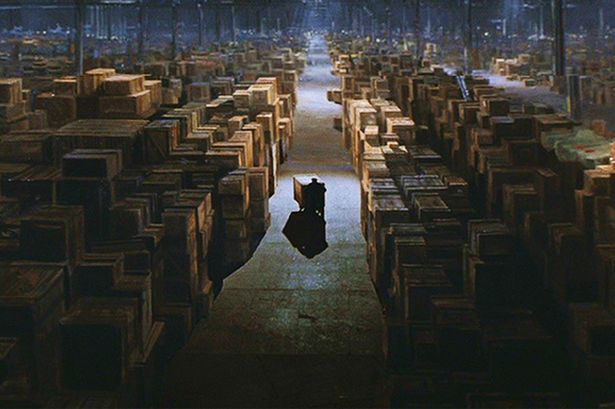MUSEUM MYSTERIES
BY:CHRISTOPHER WAI
Setting the Stage:
President Obama had finally issued an executive order at the end of last year to bar drilling permits in response to veterans joining the protests. Trump has since signed another to allow for the DAPL to resume and the issue here has been buried once again in the mass of controversies and responses to the Trump administration. Trump owns shares of stock in Energy Transfer Partners. Rick Perry, the top pick for Energy Secretary was also a board member. The volatile hierarchies I mentioned have in a sense proven itself. There have been many issues in the past week, so forgive me for some critical levity. To set the stage, I refer to you this wonderful documentary (#AlternativeFacts). Where it ends we begin.
 |
| Improper storage as shown in fiction. Raiders of the Lost Ark (1981) |
The Risk: Warping Time in Space:
In light of all the things that have happened in 2016 and in the past and upcoming weeks, this all may seem less important and yet it is all the more relevant. The all too common creation and reproduction of national mythologies used to promote specific visions and rhetoric are very much alive. The supposedly “post-truth” world or world of “alternative facts” is a dangerous one. Misinformation and confused information is a new norm and every tweet is the talk of the day.
The calls for making America great again for example implies a return to a nonexistent greatness of white picket fences and nuclear families sans nuclear fears. Maybe some image of Lewis and Clark without Sacagawea. A supposed “nativism” that is not remotely indigenous. The “origin” that is simply an imposition on a longer continuity. Perhaps it's a “captains of industry” origin without all the slave or immigrant labour. Historical archaeology in North America extends well beyond historic houses of the the gentry: slave plantations are archaeological sites, as are the remnants of life left by Chinese labourers working on the railroads (followed by Chinese immigrant bans for 61 and 24 years in the US and Canada) and the forgotten lower class apartment blocks and buried city factories that are still health hazards today.
 |
| A look into a very narrow mind. Bioshock Infinite (2013) |
 |
| Improper storage as shown in real life: US National Park Service |
In the last two parts, I've tried in my own messy way to meld the more general and complex issues of preserving archaeological sites with ongoing issue with DAPL and elsewhere, including here in Ontario. We'll now look at what happens afterwards. Collections are not simply saved. Like our present political situation down south, there is always a lot of work to maintain what good has been made. Here are a few core points:
Curation Crisis: Storage Space, Collections Stabilization and Tracking:
The curation crisis is on the face of it fairly simple and affects three major levels of archaeology in North America: Consultant, Academic and Government.
 |
| NPS |
While these surrounding issues continue to be debated in the field, the collections are stored wherever possible. What is excavated is collected, assessed, catalogued , reported on. Collections management often takes a back seat to the next project and the next bid for contracts. Salvage and pragmatically staying financially afloat as a small business are primary concerns.
Academic archaeologists in North America similarly, place grants and funding into research as the primary concern, with collections management as a necessary, but often secondary thought. Teaching and supervising graduate and undergraduate students also takes up time and university budgets but are core to its existence.
Collections for contract and academic archaeology may be found at the firm and university storage or when space gets tight, at their homes, in basements and garages. Where they go when they retire or pass on is not regulated.
Government agencies will often place more priority as heritage management and conservation of government owned lands are core components in their mandate, though it is also often imperfect due to funding. Government storage can vary greatly, though it is usually more formally regulated than the above two and more stable because of the fact that they mostly own or have some control(through easments) on the properties assessed. The more impromptu storing methods of contract and academic archaeologists would not apply so much for public servants. With that being said, technically all contemporary collections are held in trust for the government in many places, only, the government provides little financial assistance to consultants and academics in charge of those collections and has collections of their own to contend with.
As a result, in many cases, collections are also not always stabilized, but stored in whatever environment is available where RH and temperature are not necessarily regulated and where there is a risk of flooding or pests. These collections are also not often well tracked. But they continue to grow and grow and become bigger and bigger issues that are known, but difficult to resolve. Here in Ontario, John Lorinc and ASI founder Ron Williamson have even called it "Ontario's Hidden Archaeological Scandal"
Research and Grey Literature:
 |
| Practicing with a builder's level, Limeridge Monument 2013: Christopher Wai |
Collections Management Standards and Policy:
 |
| Cover of Ministry Standards and Guidelines for Fieldwork: MTCS |
Collections Density and the Danger of Deaccesioning
Archaeological collections from many excavations are often fragmentary and incredibly dense. One could feasibly find a hundred artifacts in a single box ranging from textile to bone, stone, glass and ceramic.
While many museum professionals more familiar with art and historical collections may wonder why some are not deaccessioned, like their own museum collections, it is important to note that there is a foundational difference in how these collections work. Many archaeological collections in older museums are often the result of poorly excavated contexts with minimal documentation or are acquired second hand after the fact.
However, archaeological collections created in the process of methodological excavation, while still imperfect, have very clear contexts (archaeological provenience) in relation to the site it came from. The layer it came from and the associated assemblages or buildings and features are all recorded.
These collections are often very under researched, so deaccessioning without the right expertise or also awareness of potential research methodologies may lead to mistakes.
Knapped glass, or glass bottles that have been chipped for woodworking in the past may not be recognized by many professionals unfamiliar with flintknapping techniques and might might simply be tossed as just another bottle fragment. Debitage, or the small stone flakes that are removed in the process of making tools also have developed methodologies for analysis.
Funding, Staffing and the Publics: Pragmatics and/ or Culture?
"What gets measured gets managed."- often attributed to Peter Drucker
"Even if you can't measure it, you're still responsible for it" - Paul Glen
Collections in CRM firms are not always managed or monitored by collections care professionals trained in preventative conservation practices and records management, but in an auxiliary capacity by archaeologists and is primarily focused on initial assessment/ artifact processing, reporting and facilitating research. Existing issues of depending on seasonal contract staff for field work and high turnover rates, make it difficult to include new staff for this purpose as it means a foundational change existing cultures and policies. Funding is a component, but the recognition of this issue enough to be a priority to allocate funding is also necessary.
Public and private support is also core to resolving this issue just as it is core to resolving tensions in the field. Awareness and interest in the public spheres would generate more discussion and perhaps a willingness to aid. Support by private land owners would also help avoid the perceptions of archaeological assessments as inconveniences.
Affordable Collections Transfer:
One alternative to in-house collections management is to send it off to a specialized facility. Governments that own site museums or have the funds for a purpose built building may resolve this issue internally. However, not many specialized repositories have been built to accommodate for privately held collections, though there have been some attempts. Ontario's Sustainable Archaeology project at McMaster and Western University are two..
Unfortunately, the creation of storage facilities alone is not enough, as collections must be repackaged to be adequate for transfer. It is difficult for these facilities to take in poorly packaged collections because the process of creating the facility in the first place already incurred high costs and the additional responsibility and resources expenditure to be responsible for this process while also maintaining collections already in the facility may be too much of a burden at the moment.
On the other end of the spectrum, because of the issues many CRM firms already face, as mentioned in the previous parts, finding time and resources to repackage it is also not often feasible. Museums are another option, but many museums already have existing collections concerns and will also have to be able to contend with the density of these collections.
| Sustainable Archaeology at McMaster: Globe and Mail |
Conclusion: Shortening Time or Warping Time in Space Redux
"Who controls the past controls the future; who controls the present controls the past"- George OrwellSo to reiterate, once it's out of the ground, it's empty. There are no layers of earlier occupation afterwards. History will seemingly begin with a house a fence, foundation walls and concrete buildings. Even in the case of historic American/ British- French-Canadian collections, there is a class distinction for memory. The many historic estates of the wealthiest families that are celebrated and meticulously preserved and interpreted are a testament to what represents the “beginning”, “early history”, “founding fathers”, “pioneers” “settlers”, “explorers” “discoverers”, “our foundations” “the captains of industry”, “new beginnings”, “rags to riches”, “old stuff”, “the new fertile land”, “the new world”, etc.
Time gets shortened and begins later. The wealthiest and most notable are metonyms of average life. It's the disparity between centuries vs. millenia and also class. So to summarize once again, all the reports and catalogues and bankers boxes upon bankers boxes are undeniable proof of the depth of time and complexities of existence that were once represented here in the ground, now bulldozed.
Bonus:
More from our documentary: Two professors and two government workers look for a box containing two important artifacts. I'm sad to say that the tablets were rather poorly conserved.


No comments:
Post a Comment
Note: only a member of this blog may post a comment.